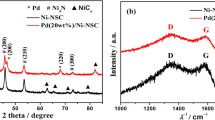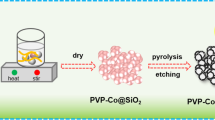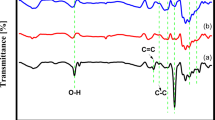Abstract
An electrochemical device for the reduction of CO2 back to liquid fuels is here presented. The key of this novel electrocatalytic approach is the design and development of the gas diffusion membrane (GDM), which is obtained by assembling (i) a proton selective membrane (Nafion), (ii) a nanocomposite electrocatalyst based on metal-doped conjugated microporous polymer (CMP) and (iii) a C-based support working as the gas diffusion layer. CMP is a very attractive material able to adsorb CO2 selectively with respect to other gases (such as H2, O2, N2, etc.), also in mild conditions (r.t. and atmospheric pressure). Particularly, tetrakis-phenylethene conjugated microporous polymer (TPE-CMP) was synthesized through Yamamoto homo-coupling reaction. TPE-CMP was modified by depositing noble (Pt) and non-noble (Fe) metal nanoparticles to create the active catalytic sites for the process of CO2 reduction directly on the polymer surface where CO2 is adsorbed. The metal-doped TPE-CMP electrocatalysts were fully characterized by infrared spectroscopy (IR), thermo-gravimetric analysis (TGA) and transmission electron microscopy (TEM). Then, the as-assembled GDM was tested in our homemade semi-continuous three-electrode electrochemical cell working in gas phase at 60 °C, coupled with a cold trap for the accumulation of the liquid products. Results showed the better performances of the metal-doped TPE-CMP in terms of total productivity (C1–C8 oxygenates) with respect to other kinds of materials that do not show high CO2 adsorption capacity.











Similar content being viewed by others
References
Centi G, Perathoner S, Passalacqua R, Ampelli C (2011) Solar production of fuels from water and CO2. In: (Eds.) NZMaTNV (ed) Carbon-neutral fuels and energy carriers. Series: green chemistry and chemical engineering. CRC Press (Taylor & Francis group), Boca Raton, FL (US), pp 291–323
Genovese C, Ampelli C, Perathoner S, Centi G (2013) A Gas-phase electrochemical reactor for carbon dioxide reduction back to liquid fuels. Chem Eng Tran 32:289–294. doi:10.3303/CET1332049
Songolzadeh M, Soleimani M, Takht Ravanchi M, Songolzadeh R (2014) Carbon dioxide separation from flue gases: a technological review emphasizing reduction in greenhouse gas emissions. Sci World J 2014:828131. doi:10.1155/2014/828131
Leung DYC, Caramanna G, Maroto-Valer MM (2014) An overview of current status of carbon dioxide capture and storage technologies. Renew Sustain Energy Rev 39:426–443. doi:10.1016/j.rser.2014.07.093
Huck JM, Lin L-C, Berger AH, Shahrak MN, Martin RL, Bhown AS, Haranczyk M, Reuter K, Smit B (2014) Evaluating different classes of porous materials for carbon capture. Energy Environ Sci. doi:10.1039/C4EE02636E
Yang L, Wang H (2014) Recent advances in carbon dioxide capture, fixation, and activation by using n-heterocyclic carbenes. Chem Sus Chem 7(4):962–998. doi:10.1002/cssc.201301131
Genovese C, Ampelli C, Perathoner S, Centi G (2013) Electrocatalytic conversion of CO2 on carbon nanotube-based electrodes for producing solar fuels. J Catal 308:237–249. doi:10.1016/j.jcat.2013.08.026
Ampelli C, Centi G, Passalacqua R, Perathoner S (2010) Synthesis of solar fuels by a novel photoelectrocatalytic approach. Energy Environ Sci 3(3):292–301. doi:10.1039/B925470f
Ampelli C, Genovese C, Perathoner S, Centi G, Errahali M, Gatti G, Marchese L (2014) An electrochemical reactor for the CO2 reduction in gas phase by using conductive polymer based electrocatalysts. Chem Eng Trans 41:13–18. doi:10.3303/CET1441003
Herron JA, Kim J, Upadhye AA, Hubera GW, Maravelias CT (2014) A general framework for the assessment of solar fuel technologies. Energy Environ Sci. doi:10.1039/C4EE01958J
Ampelli C, Genovese C, Passalacqua R, Perathoner S, Centi G (2012) The use of a solar photoelectrochemical reactor for sustainable production of energy. Theor Found Chem Eng 46(6):651–657. doi:10.1134/S0040579512060012
Ampelli C, Passalacqua R, Perathoner S, Centi G (2011) Development of a TiO2 nanotube array-based photo-reactor for H2 production by water splitting. Chem Eng Trans 24:187–192. doi:10.3303/Cet1124032
Passalacqua R, Ampelli C, Perathoner S, Centi G (2012) Anodically formed TiO2 thin films: evidence for a multiparameter dependent photocurrent-structure relationship. Nanosci Nanotechnol Lett 4(2):142–148. doi:10.1166/nn1.2012.1303
Errahali M, Gatti G, Tei L, Canti L, Fraccarollo A, Cossi M, Marchese L (2014) Understanding methane adsorption in porous aromatic frameworks: an FTIR, Raman, and theoretical combined study. J Phys Chem C 118(19):10053–10060. doi:10.1021/jp412572e
Ampelli C, Passalacqua R, Genovese C, Perathoner S, Centi G, Montini T, Gombac V, Fornasiero P (2013) Solar energy and biowaste conversion into H2 on CuOx/TiO2 nanocomposites. Chem Eng Trans 35:583–588. doi:10.3303/CET1335097
Ampelli C, Passalacqua R, Genovese C, Perathoner S, Centi G, Montini T, Gombac V, Jaen JJD, Fornasiero P (2013) H2 production by selective photo-dehydrogenation of ethanol in gas and liquid phase on CuOx/TiO2 nanocomposites. RSC Adv 3(44):21776–21788. doi:10.1039/C3ra22804e
You H-S, Jin H, Mo Y-H, Park S-E (2013) CO2 adsorption behavior of microwave synthesized zeolite beta. Mater Lett 108:106–109. doi:10.1016/j.matlet.2013.06.088
Auta M, Hameed BH (2014) Adsorption of carbon dioxide by diethanolamine activated alumina beads in a fixed bed. Chem Eng J 253:350–355. doi:10.1016/j.cej.2014.05.018
Ye S, Jiang X, Ruan L-W, Liu B, Wang Y-M, Zhu J-F, Qiu L-G (2013) Post-combustion CO2 capture with the HKUST-1 and MIL-101(Cr) metal–organic frameworks: adsorption, separation and regeneration investigations. Microporous Mesoporous Mater 179:191–197. doi:10.1016/j.micromeso.2013.06.007
Tong M, Yang Q, Xiao Y, Zhong C (2014) Revealing the structure-property relationship of covalent organic frameworks for CO2 capture from postcombustion gas: a multi-scale computational study. Phys Chem Chem Phys 16(29):15189–15198. doi:10.1039/c4cp02047b
Ben T, Qiu S (2013) Porous aromatic frameworks: synthesis, structure and functions. CrystEngComm 15(1):17–26. doi:10.1039/c2ce25409c
Fraccarollo A, Canti L, Marchese L, Cossi M (2014) Monte carlo modeling of carbon dioxide adsorption in porous aromatic frameworks. Langmuir 30:4147–4156
Yang D-A, Cho H-Y, Kim J, Yang S-T, Ahn W-S (2012) CO2 capture and conversion using Mg-MOF-74 prepared by a sonochemical method. Energy Environ Sci 5:6465–6473. doi:10.1039/c1ee02234b
Liu X, Li H, Zhang Y, Xu B, Sigen A, Xia H, Mu Y (2013) Enhanced carbon dioxide uptake by metalloporphyrin-based microporous covalent triazine framework. Polym Chem 4(8):2445–2448. doi:10.1039/c3py00083d
Xu Y, Chen L, Guo Z, Nagai A, Jiang D (2011) Light-emitting conjugated polymers with microporous network architecture: interweaving scaffold promotes electronic conjugation, facilitates exciton migration, and improves luminescence. J Am Chem Soc 133(44):17622–17625. doi:10.1021/ja208284t
Xu Y, Jin S, Xu H, Nagai A, Jiang D (2013) Conjugated microporous polymers: design, synthesis and application. Chem Soc Rev 42(20):8012–8031. doi:10.1039/c3cs60160a
Xie Y, Wang TT, Liu XH, Zou K, Deng WQ (2013) Capture and conversion of CO2 at ambient conditions by a conjugated microporous polymer. Nature Commun 4:1960. doi:10.1038/ncomms2960
Dawson R, Adams DJ, Cooper AI (2011) Chemical tuning of CO2 sorption in robust nanoporous organic polymers. Chem Sci 2:1173–1177. doi:10.1039/c1sc00100k
Demir-Cakan R, Morcrette M, Nouar F, Davoisne C, Devic T, Gonbeau D, Dominko R, Serre C, Ferey G, Tarascon J-M (2011) Cathode Composites for Li–S batteries via the use of oxygenated porous architectures. J Am Chem Soc 133(40):16154–16160. doi:10.1021/ja2062659
Genovese C, Ampelli C, Perathoner S, Centi G (2013) Electrocatalytic conversion of CO2 to liquid fuels using nanocarbon-based electrodes. J Energy Chem 22(2):202–213
Ampelli C, Passalacqua R, Genovese C, Perathoner S, Centi G (2011) A novel photo-electrochemical approach for the chemical recycling of carbon dioxide to fuels. Chem Eng Trans 25:683–688. doi:10.3303/Cet1125114
Ampelli C, Passalacqua R, Perathoner S, Centi G, Su DSS, Weinberg G (2008) Synthesis of TiO2 Thin films: relationship between preparation conditions and nanostructure. Top Catal 50(1–4):133–144. doi:10.1007/s11244-008-9113-0
Ampelli C, Passalacqua R, Perathoner S, Centi G (2009) Nano-engineered materials for H2 production by water photo-electrolysis. Chem Eng Trans 17:1011–1016. doi:10.3303/Cet0917169
Kuhl KP, Cave ER, Abram DN, Jaramillo TF (2012) New insights into the electrochemical reduction of carbon dioxide on metallic copper surfaces. Energy Environ Sci 5(5):7050. doi:10.1039/c2ee21234j
Ampelli C, Genovese C, Passalacqua R, Perathoner S, Centi G (2014) A gas-phase reactor powered by solar energy and ethanol for H2 production. Appl Therm Eng 70(2):1270–1275. doi:10.1016/j.applthermaleng.2014.04.013
Kopljar D, Inan A, Vindayer P, Wagner N, Klemm E (2014) Electrochemical reduction of CO2 to formate at high current density using gas diffusion electrodes. J Appl Electrochem 44(10):1107–1116. doi:10.1007/s10800-014-0731-x
Wang Q, Dong H, Yu H, Yu H (2015) Enhanced performance of gas diffusion electrode for electrochemical reduction of carbon dioxide to formate by adding polytetrafluoroethylene into catalyst layer. J Power Sources 279:1–5. doi:10.1016/j.jpowsour.2014.12.118
Ampelli C, Perathoner S, Centi G (2015) CO2 utilization: an enabling element to move to a resource and energy-efficient chemical and fuel production. Phil Trans R Soc A 373(20140177):1–35. doi:10.1098/rsta.2014.0177
Qiao J, Liu Y, Hong F, Zhang J (2014) A review of catalysts for the electroreduction of carbon dioxide to produce low-carbon fuels. Chem Soc Rev 43:631–675. doi:10.1039/c3cs60323g
Wang D, Villa A, Porta F, Su D, Prati L (2006) Single-phase bimetallic system for the selective oxidation of glycerol to glycerate. Chem Commun 18:1956–1958. doi:10.1039/B518069D
Freund H-J, Roberts MW (1996) Surface chemistry of carbon dioxide. Surf Sci Rep 25(8):225–273. doi:10.1016/S0167-5729(96)00007-6
Fastow M, Kozirovski Y, Folman M (1993) IR spectra of CO2 and N2O adsorbed on C60 and other carbon allotropes—a comparative study. J Electron Spectrosc Relat Phenom 64–65(C):843–848. doi:10.1016/0368-2048(93)80158-I
Mawhinney DB, Rossin JA, Gerhart K, Yates JT Jr (1999) Adsorption and reaction of 2-chloroethylethyl sulfide with Al2O3 surfaces. Langmuir 15(14):4789–4795. doi:10.1021/la981440v
Kazarian SG, Vincent MF, Bright FV, Liotta CL, Eckert CA (1996) Specific intermolecular interaction of carbon dioxide with polymers. J Am Chem Soc 118(7):1729–1736. doi:10.1021/ja950416q
Matranga C, Chen L, Smith M, Bittner E, Johnson JK, Bockrath B (2003) Trapped CO2 in Carbon Nanotube Bundles. J Phys Chem B 107(47):12930–12941
Hori Y (2008) Electrochemical CO2 reduction on metal electrodes. In: Constantinos G, Vayenas C, White RE, Gamboa-Aldeco ME (eds) Modern aspects of electrochemistry, vol 42. Springer, New York, pp 89–189. doi:10.1007/978-0-387-49489-0_3
Ampelli C, Perathoner S, Centi G (2014) Carbon-based catalysts: opening new scenario to develop next-generation nano-engineered catalytic materials. Chin J Catal 35(6):783–791. doi:10.1016/S1872-2067(14)60139-X
Gangeri M, Perathoner S, Caudo S, Centi G, Amadou J, Bégin D, Pham-Huu C, Ledoux MJ, Tessonnier JP, Su DS (2009) Fe and Pt carbon nanotubes for the electrocatalytic conversion of carbon dioxide to oxygenates. Catal Today 143(1–2):57–63. doi:10.1016/j.cattod.2008.11.001
Acknowledgments
The authors would like to acknowledge the Italian Ministry of Education, University and Research (MIUR) for the financial support in the framework of the Project PRIN 2010–2011 (Mechanisms of CO2 activation for the design of new materials for energy and resource efficiency).
Author information
Authors and Affiliations
Corresponding author
Rights and permissions
About this article
Cite this article
Ampelli, C., Genovese, C., Errahali, M. et al. CO2 capture and reduction to liquid fuels in a novel electrochemical setup by using metal-doped conjugated microporous polymers. J Appl Electrochem 45, 701–713 (2015). https://doi.org/10.1007/s10800-015-0847-7
Received:
Accepted:
Published:
Issue Date:
DOI: https://doi.org/10.1007/s10800-015-0847-7




